I always considered popularizing 3D printing and making it accessible and comprehensive to “normal” people (read: not hardcore nerds ;-)) as an equally important mission as improving the technology itself. Let’s face it: even the most user-friendly 3D printers are not plug-and-play devices for everyone, like a TV set or a cell phone. First, you need to learn some skills to handle them properly.
That’s why we have always put such a strong emphasis on the quality of our assembly manuals, why we maintain a vast Knowledge Base, and why we publish so many blog articles and videos with various tips, tricks, and how-tos.
As a logical progression of these efforts, I would now like to present to you the Prusa Academy: a library of online courses on 3D printing. We will cover everything from the very basics to advanced 3D topics, focused both on our products and general 3D printing related stuff.
Now, let’s see what we have prepared and go through all the details.
What courses are available already?
So far, we have published three of them:
- 3D Printing and Modeling for Beginners (Original Prusa i3 MK3S+)
- 3D Printing and Modeling for Beginners (Original Prusa MINI+)
- Design Principles for 3D Printed Parts
The main target audience of the two beginners’ courses is absolute 3D printing newbies who purchase an assembled variant of the printer. However, most of the content is equally useful for people with the kit variant, or, actually, even for owners of just about any 3D printer out there.
The lessons follow a very straightforward path, getting to the first successful print as quickly as possible. We start with unboxing the printer, setting it up, and printing one of the enclosed sample models. All the basic 3D printing terminology, how the printer works, and how to take care of it properly, are explained on the fly.
However, we don’t stop there. Obviously, printing just sample models would be a very limited 3D printing experience. 🙂 In the subsequent lessons, we focus on where to download more 3D models (introducing Printables.com), how to prepare them for 3D printing with PrusaSlicer, and ultimately, how to create your own simple designs, using Tinkercad or Fusion 360.
By the way, both these courses have been around for a while – we have been giving them for free to everyone who bought the assembled variant of our printers (and we will continue to do so). Also, we used them as an onboarding tool for hundreds of teachers who participate in our partnership project with Czech schools. This means we were already able to incorporate a lot of feedback and turn the courses into a solid product.
Important notice: If you got one of the courses earlier for free and now you have trouble logging in, please be patient, this is just a side-effect of migrating to the new platform. Your access will be restored soon. Thanks for understanding!
Note that the beginners’ courses are not meant to replace our existing free sources of information, like the Knowledge Base or the 3D printing handbooks. It’s just that they should offer a more streamlined, beginner-friendly option, taking advantage of more interactive and visual tools.
The third course, Design Principles for 3D Printed Parts, was created in collaboration with Joseph Casha of the Breaks’n’Makes Youtube channel. It is aimed at people who already know the basics of 3D modeling, but struggle with adapting to the specific limitations of 3D printing. Dealing with overhangs, visible print layers, shrinking or warping…many of these issues can be mitigated already during the modeling process. The tricks featured in this course should help you to make your designs both more functional and better looking.
It goes without saying that this course is also suitable for owners of any 3D printer, not just the Original Prusa machines.
How are the courses arranged?
One of the main dilemmas when preparing any educational content is the choice between a video-based and a text-based form.
Videos are fun and very effective in explaining more difficult concepts. However, a big problem with videos is that the narrator dictates the pace, which rarely feels comfortable. You have to pause it, jump back, or frantically skip forward, hoping to get to the point. Compared to reading, listening takes little active effort, which is a double-edged sword: far too often it invites treating the video just as pleasant background noise, without actually learning anything.
On the other hand, a purely text-based course could easily become overwhelming, tedious, and just far too reminiscent of school :-). Also, some topics are very difficult to grasp just from text and static pictures.
In the end, we went with sort of a hybrid text-based form, however, we focused on making it as streamlined, comprehensive, and easy-flowing as possible. Everything is arranged in short paragraphs, using icons and color-coding to mark extra tips, warnings, active tasks, etc. We also use tooltips to explain some technical terms without having to clutter the main text with definitions. There are also many useful links to other information sources like our blog articles or the Knowledge Base, for inspiration and further study.
Of course, there are also a lot of pictures, and whenever a static picture won’t do, we use videos, or rather just a few seconds long animations in the WebM format, which are quick to load and short enough so they are not distracting.
Each course contains quizzes to help you check your newly gained knowledge along the way. If you make any mistakes, you can return to the lessons, catch up, and attempt again as many times as you like. If you pass all of the quizzes successfully, you will get a nice certificate with your name on it. Keep in mind that if you don’t care about the certificate, none of the quizzes are mandatory. You don’t have to “unlock” anything, the whole content of each course is available right from the beginning. Advance at your own pace, jump back and forth, and skip whatever you want (at your own risk, of course ;-)).
By the way, the same as with the vast majority of our content, all the courses will be localized into multiple languages. The translations are not completely finished yet but should be in about a week.
Purchasing the courses
As for the pricing, the existing courses cost 5-10 USD. Think of it like buying some expert a couple of coffees or drinks in exchange for hearing everything he knows about some broad 3D printing related topic. That sounds like a good bargain to me 😉
As for the purchase process, Prusa Academy courses have their own category in our regular e-shop and everything is therefore very similar. Keep in mind though, that you cannot mix the courses with regular products, there have to be separate orders. Right after the purchase, you will get a confirmation email with a link to the course. Then you can access it with your Prusa Account credentials (i.e. the same login as for the e-shop, Printables.com, etc.). No extra registration is needed. Also, there are no limits regarding the number of devices or whatnot.
What’s in the pipeline?
The current offer of courses is very modest because so far we focused more on developing and bug-fixing the interface and polishing the existing content. There are so many topics to cover! The following currently have priority:
There will be a whole series of courses on various stages of postprocessing – from basic filling, sanding, and gluing to advanced airbrush techniques.
Fusion 360 is a solid CAD tool while being very beginner-friendly at the same time – it will be our choice for a full-blown 3D modeling course.
The PrusaSlicer lesson in the existing beginners’ courses packs a lot of information, actually, it’s the longest lesson by far, even though it only covers the Simple (Green) menu options plus a few extra tricks. It is obvious that a really thorough, complete A-Z PrusaSlicer guide is long due.
And of course, we would like a make a course about our SL1S printer and/or SLA technology in general.
By the way, we take pride in the long-term support of our products, and the online courses are no different from our printers in this regard. So, you can expect continuous little updates and fixes to the existing content.
If you have an interesting idea for a course topic yourself, do not hesitate to contact us, perhaps we can figure out something together. Actually, as mentioned above, one of the existing courses, Design Principles for 3D Printed Parts, is a result of such collaboration.
That is all for now, however, we will come back to you soon with information about the progress on the new courses.
In the meantime, enjoy Prusa Academy, and please feel free to give us any feedback.
Happy learning!






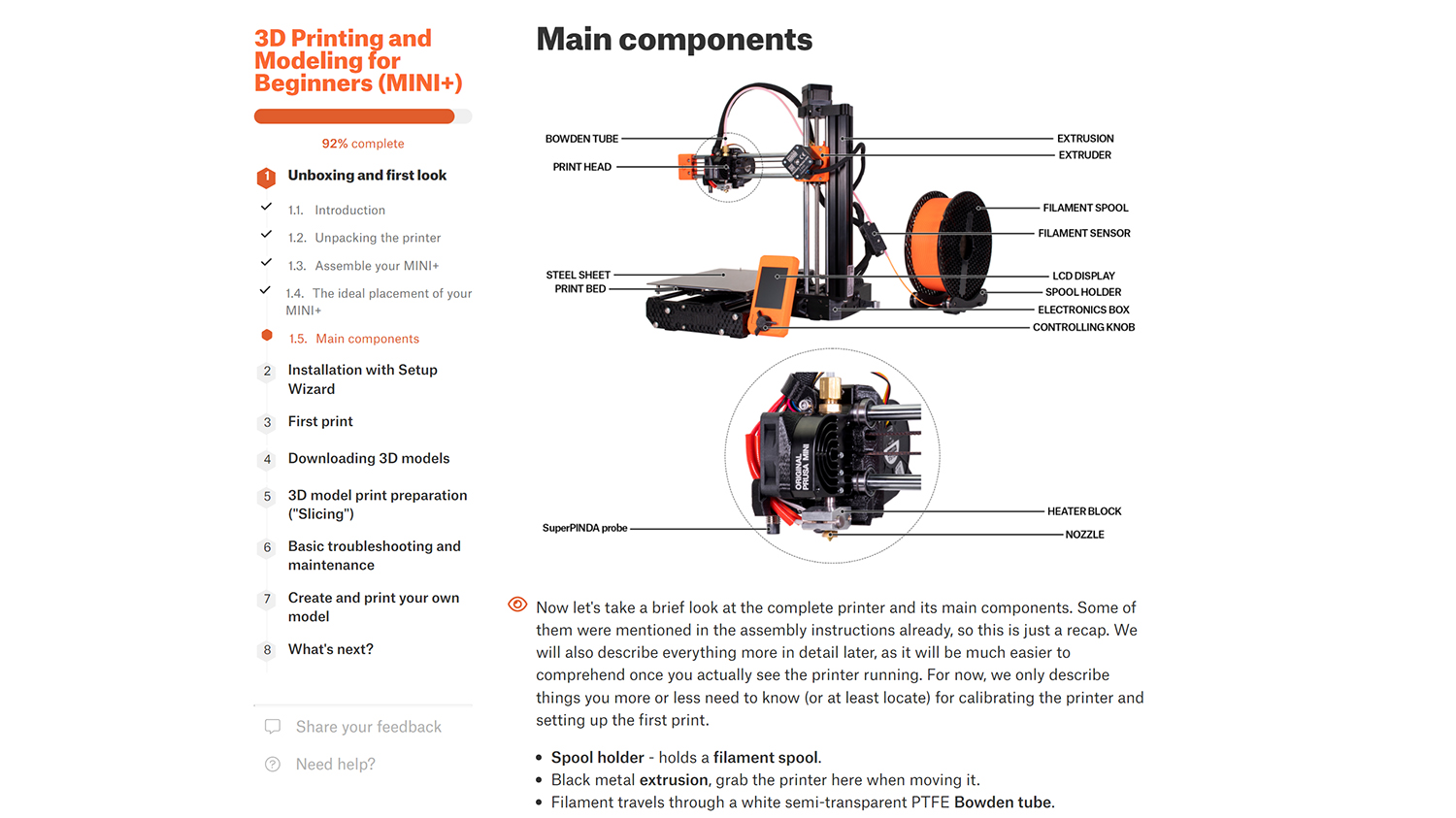
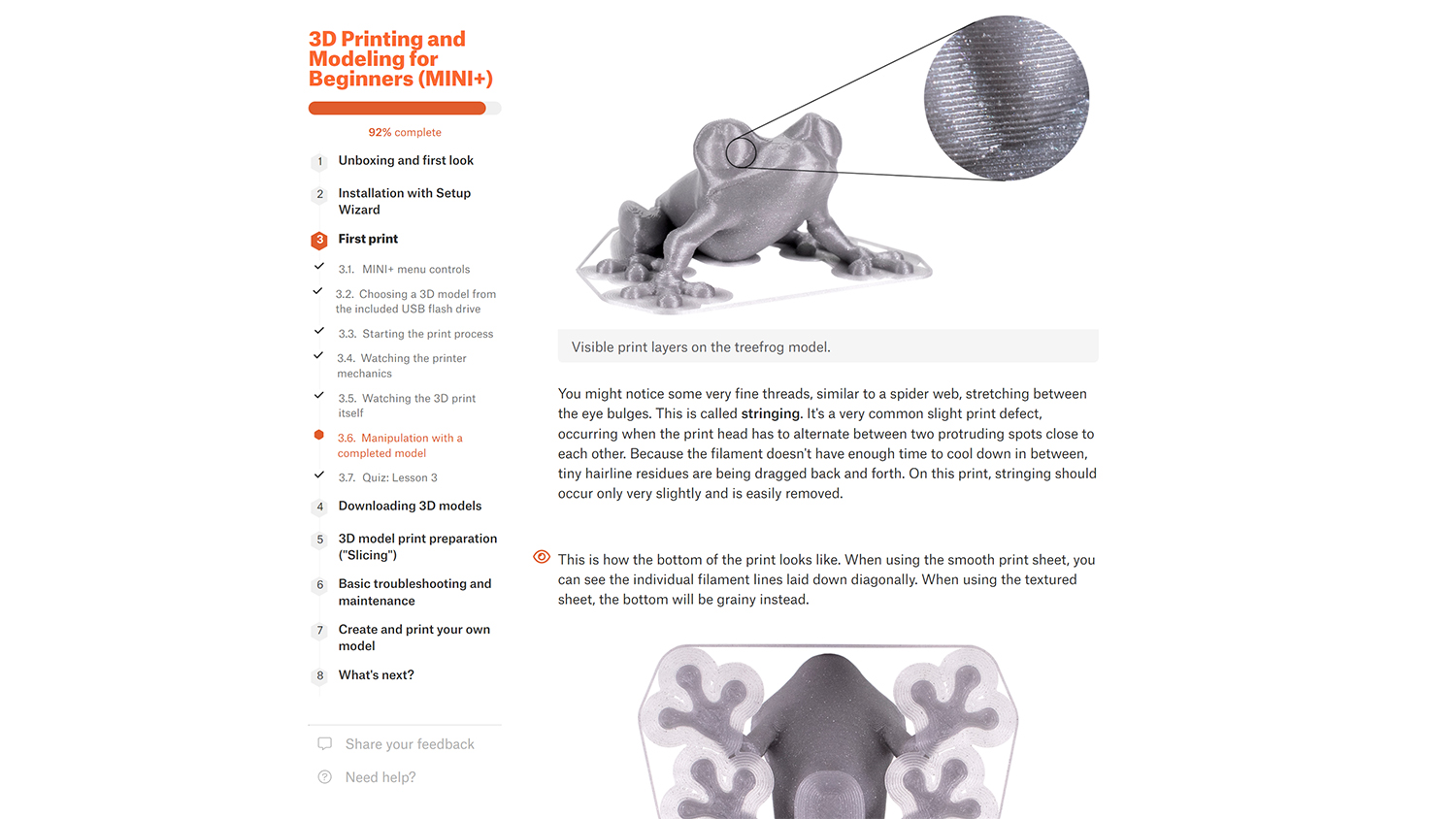
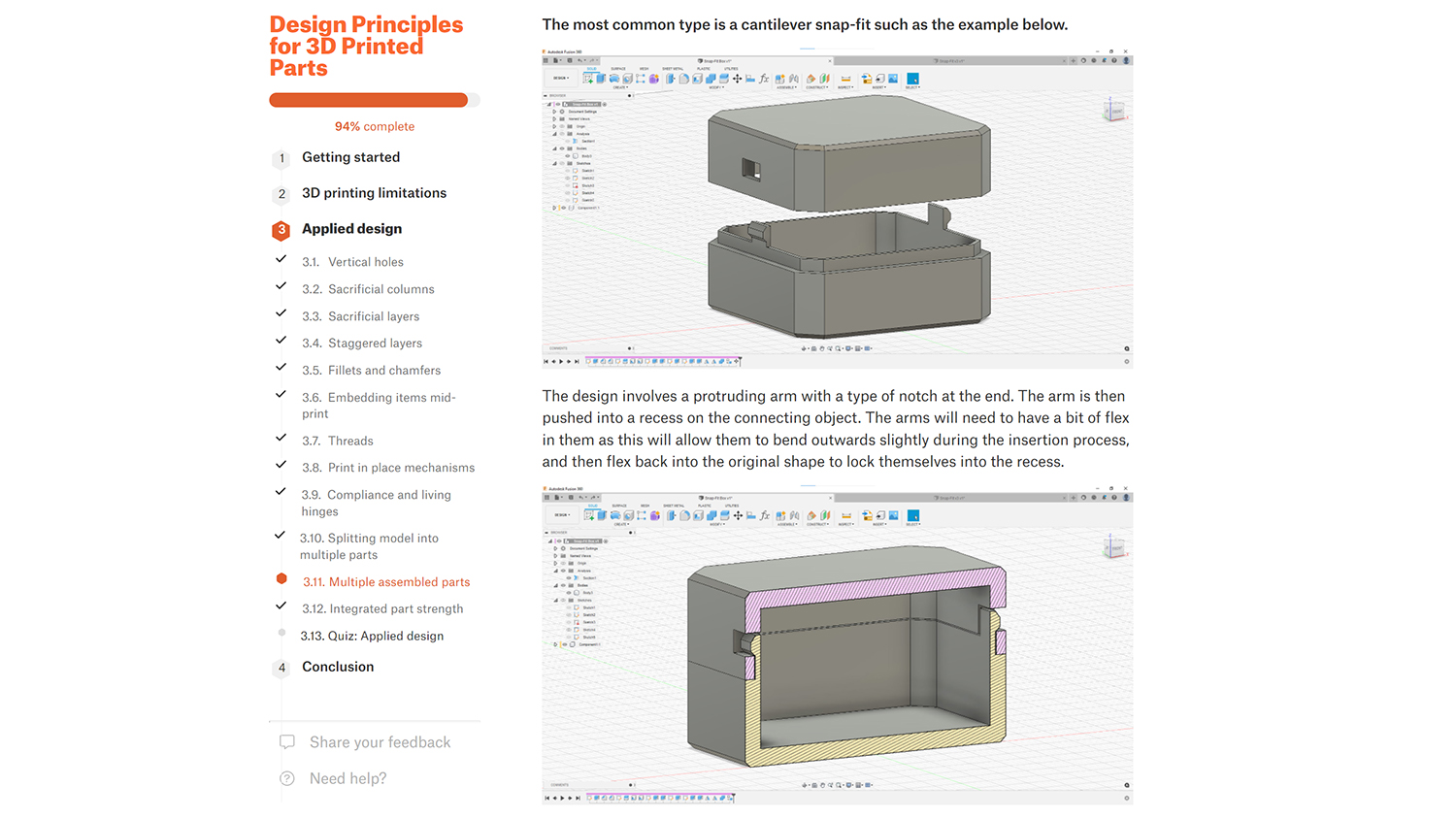
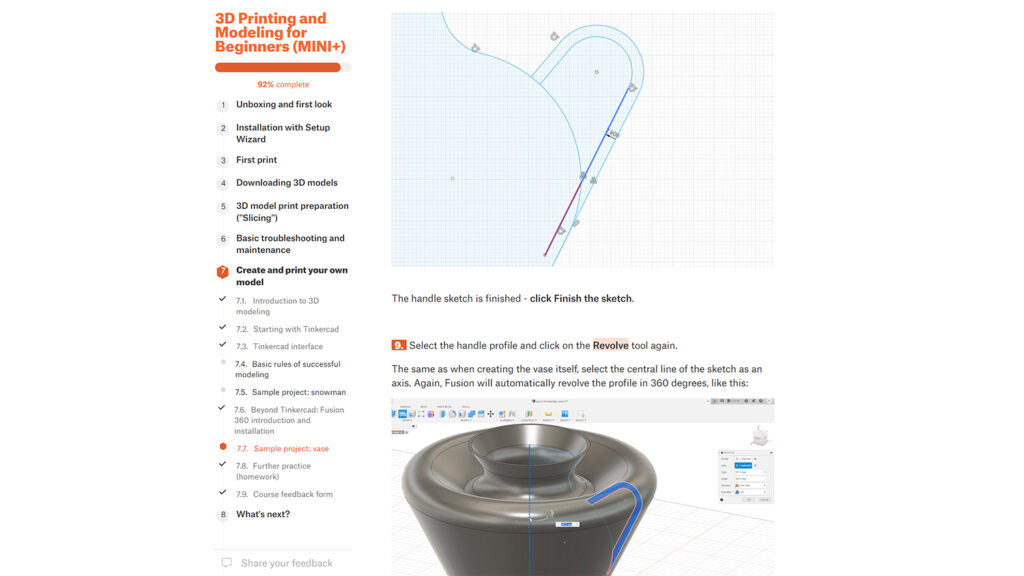


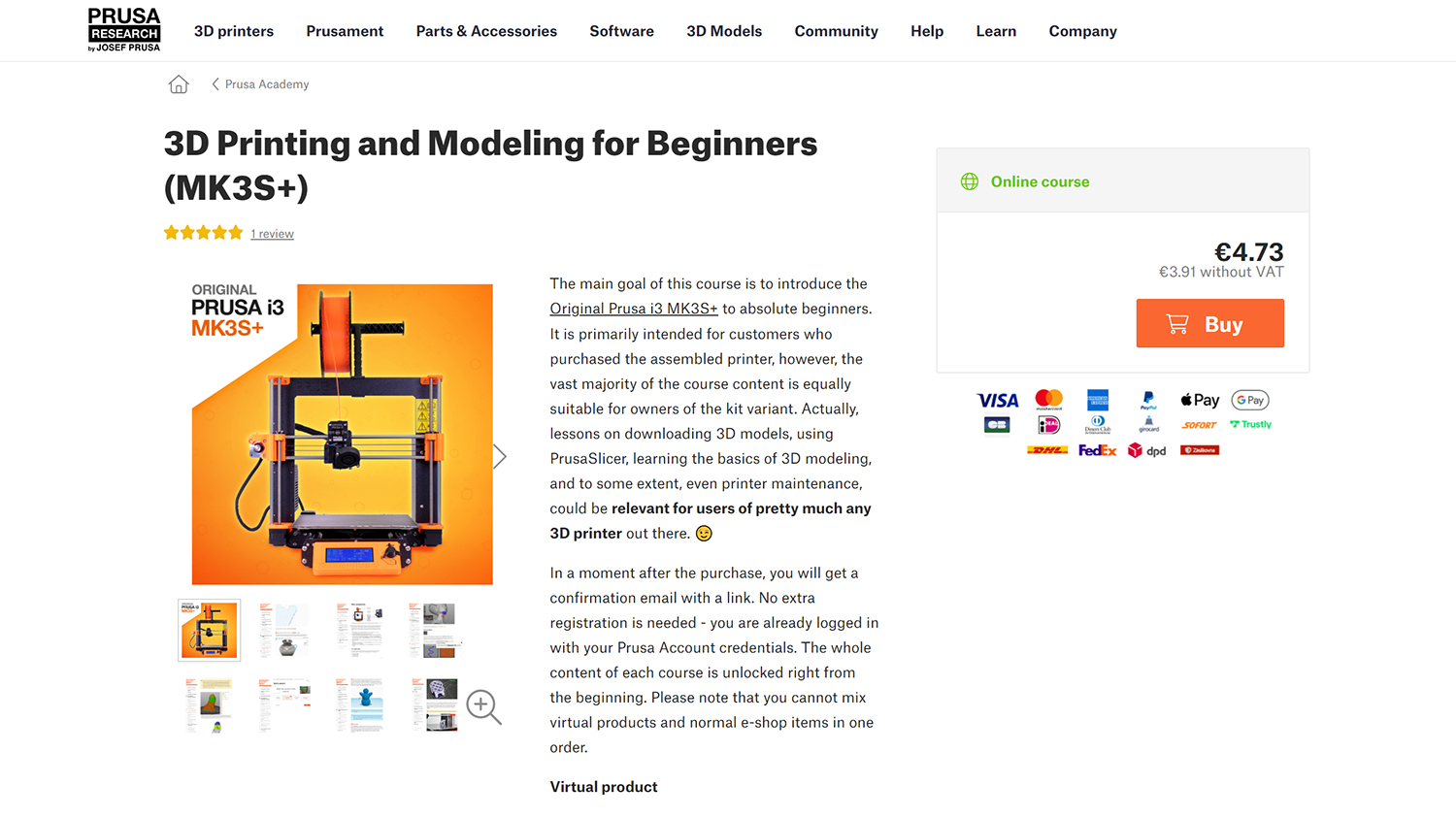
Why proprietary visual modeling tools rather than open-source code-based tools like CadQuery?
@mmirate while Fusion 360 isn’t open source, it is free for personal use and to my knowledge probably the software with the most available features and probably also one of the most common software used by makers and 3D printers
il nest plus gratuit
As someone who works for a US School District, it would be interesting to see what it would take to make these courses available to all our interested teachers without asking them to pay on their own.
As en educator myself, I would like to know this too.
+1 on some kind of institutional/educator pricing for these courses. I’d love to be able to assign one of these courses as a part of my digital fabrication class.
Good post! Thanks
I went ahead and took the designing for 3D printed parts. Really loved the knowledge regarding designing 3D printed parts on there. My only ask is that maybe we get a video course of the sections? Showing off those sweet Prusa machines and all! 🙂
As a nice gesture, perhaps consider making the courses free to those who have purchased a Prusa printer
I’d love to see a course on specifically how to maintain a Prusa printer. Maybe such a thing exists and I missed it. I think I read it may be part of another video but having a specific video would be awesome. Thanks.
Is it possible to revisit certain chapters of the course?
Of course, you can read any part of it at any time.
I love the idea behind this. One suggestion for a future course is Design for Mechanical 3D Prints. I’ve always struggled getting the tolerances, friction, and strength just right to get gears and moving parts working. Meanwhile there are people like JBV Creative on YouTube making massive geared assemblies. Wish I could pick his brain on how he designs and tests that stuff. If you guys could distill that into a course, I think we’d see a LOT more dynamic 3D print models on printables.com!
Over time, I realized that it is difficult to find really high-quality help, it is important for me that the resource meets several mandatory criteria.
You are rally right with thuis remake. I want to make step up tools for disabled People in a combination of cnc produced mechanical party and 3D printer plastic party. The mechanica parts for the most strong party and the 3d parts for the most complex ons. For instantie for mecanum wheels for wheelchairs.
Thanks
moi j utilise freecad il est gratuit
fusion n est plus gratuit